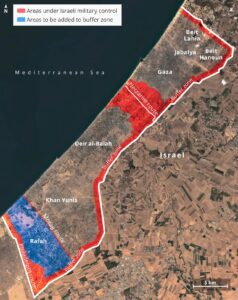Haaretz: Israel Preparing to Turn Rafah – One-fifth of Gaza – Into Part of Buffer Zone
The Israeli military reports that the area to be confiscated includes the city of Rafah and its surrounding neighborhoods in the Gaza Strip. Palestinian residents will compelled to leave and not allowed to return.
If the plan is carried out fully, the people of Gaza will be confined to two distinct areas and surrounded by Israeli military zones.
By Yaniv Kubovich, Reposted from Haaretz, April 09, 2025
The Israeli military is preparing to incorporate the southern Gaza city of Rafah and its surrounding neighborhoods into the buffer zone it is establishing along the border.
The area, located between the Philadelphi route to the south and the Morag route to the north, was home to around 200,000 Palestinians before the war. In recent weeks, however, it has been left almost entirely deserted following widespread destruction caused by the Israeli military.
Following the end of the cease-fire, the army called on the remaining civilians to evacuate and move to the designated humanitarian zone along the coastline, around Khan Yunis and the Muwasi area.
Until now, the military has refrained from incorporating large cities like Rafah into the buffer zone. According to defense officials, the move to include Rafah came after the government’s decision to resume the war in February, and against the backdrop of Prime Minister Benjamin Netanyahu’s statement that Israel would seize large areas of Gaza. In some respects, it appears the army is seeking to replicate in the south the methods it employed in northern Gaza.

Expanding the buffer zone to this extent carries significant implications. Not only does it cover a vast area – approximately 75 square kilometers (about 29 square miles), or roughly one-fifth of the Gaza Strip – but severing it would effectively turn Gaza into an enclave within Israeli-controlled territory, cutting it off from the Egyptian border. According to defense sources, this consideration played a central role in the decision to focus on Rafah.
The sources added that the move is also intended to create new levers of pressure on Hamas. Within the military, there is a growing understanding that Israel is unlikely to receive international backing – including from Washington – for a prolonged campaign in Gaza. Likewise, threats by Israeli cabinet ministers to block humanitarian aid are not expected to translate into actual policy.
As a result, the military is preparing to concentrate its operations in areas where it believes it can maximize the pressure on Hamas’ leadership. Rafah, both because of its size and its strategic location along the Egyptian border, has become a particularly attractive target.
As part of its preparations, the military is already working to expand the Morag route, demolishing structures along its path. In some sections, the route will be several hundred meters wide, and in certain areas, it could exceed a kilometer.
According to defense sources, it has yet to be decided whether the entire area will simply be designated a buffer zone that is off-limits to civilians – as has been done in other parts of the border area – or whether the area will be fully cleared and all buildings demolished, effectively wiping out the city of Rafah.
Unnecessary risks
When the war began in October 2023, the military announced plans to create a buffer zone along the Gaza Strip’s border, intended to push threats away from Israeli border communities by a distance of 800 meters to 1.5 kilometers (approximately 0.5 to 0.9 miles). The zone spans about 60 square kilometers (roughly 23 square miles) – more than 16 percent of the entire Gaza Strip – and, as of October 7, was home to around a quarter of a million Palestinians. A report by the United Nations Satellite Center, published in April 2024, found that by then, roughly 90 percent of the buildings within the buffer zone had been destroyed or damaged.
However, the military’s new activity in the area is not limited to the stretch between the Morag route and the Philadelphi route. In recent weeks, soldiers have begun taking up positions along the entire perimeter, in what appears to be a preliminary move.
“There’s nothing left to destroy in the buffer zone,” said a commander who fought for more than 240 days in the Gaza Strip and took part in demolishing structures and clearing operations along the buffer zone and the Netzarim route.
“The entire area is unfit for human habitation. There’s no need to send so many soldiers into these places.” He and other soldiers voiced deep frustration over the plan to renew operations in these areas.
Reservist commanders and soldiers said that the military is repeating the same messages it used at the start of the war, without confronting the reality on the ground. “I can’t believe that after a year and a half, we’re back to square one,” said a soldier from a reserve brigade currently serving in the Gaza Strip. “We’re being sent to destroy what’s already been destroyed, without anyone knowing how long it will take, what the actual goal is, or what level of operational success is needed for the forces to complete the mission.”
When soldiers and commanders speak about operational accidents, there is more than one incident that can already be cited as an example. The deadliest occurred in January 2024, when 21 reservists were killed during an explosion while demolishing buildings in the buffer zone near the Kissufim crossing in central Gaza.

The soldiers had rigged a two-story building located about 600 meters (approximately 0.3 miles) from the border fence. However, it appears that an anti-tank missile was fired at the building, where dozens of soldiers had gathered in violation of safety protocols and orders. More than a year later, the military has still not released the findings of its investigation into the incident.
There have been other deadly incidents. In January, five soldiers from the Nahal Brigade were killed in an explosion at a building they were occupying in Beit Hanoun. In December 2023, two soldiers were killed when a building collapsed in Rafah. These are not the only examples.
Red zone, green zone
However, as the army resumes clearing operations and seizing control of parts of Gaza, additional concerns are expected to arise, particularly regarding the potential harm to the civilian population.”We don’t just wake up in the morning, put a D9 [armored bulldozer] into gear and destroy neighborhoods,” said a senior commander who led forces in combat in Gaza. However, he added: “If we need to advance into certain areas, we will not endanger our forces by risking exposure to booby traps and explosives.”
Commanders and soldiers – some of whom also gave testimony to the organization Breaking the Silence – attempt to describe how, in practice, the balance is struck between “not waking up in the morning and destroying neighborhoods,” as the senior officer claimed, and “not risking the troops.”
“If we identify suspects, we shoot at them. We want them to learn that they’re not allowed to leave [their homes],” said a tank soldier who previously took part in clearing operations along the buffer zone. “If a building overlooks the fence and it’s possible to fire from there at the fence, it will be destroyed,” he said. “The D9 goes through and knocks down everything in its path.
Everything means everything. We’re done, really, that’s the order. We’re done with the nonsense. No games,” he said. According to him, the prevailing attitude on the ground was: “There are no civilians in the area. They’re all terrorists. There are no innocents. Why would someone come within 500 meters of my tank?”

According to the accounts of commanders and soldiers, the military’s Gaza Division created a color-coded map of areas within the buffer zone, which was updated from time to time. The zones were marked red, orange, yellow and green – with green indicating that more than 80 percent of the structures in that area had been destroyed. The color map included residential buildings, greenhouses, sheds, factories – “you name it,” one soldier said.
In practice, the map also turned the demolition of buildings into a competition between units, with each commander eager to show that their sector was greener. “It was a great source of pride,” said a soldier from one of the reserve brigades that took part in clearing operations along the buffer zone.
The army’s rules of engagement may come under renewed scrutiny due to the possibility of encounters between soldiers and civilians who either refuse to leave their homes or simply lose their way.
“There was no clear regulation of the rules of engagement at any stage,” said a reservist tank officer who fought for hundreds of days in Gaza. “Any movement by people was considered suspicious, because we decided it was. You find something relevant and shoot at it … The distinction between civilian infrastructure and terrorist infrastructure didn’t matter; no one cared.”
According to him, this was true even within the buffer zone. “We set a line – a boundary –beyond which everyone was considered a suspect,” he said. But I’m not sure how many Palestinians even knew where that line was. There’s no marking on the ground; it’s just an imaginary line about a kilometer from the border.”
He added that there was an informal code for how to respond: “If it’s an adult man, kill him. Women and children – fire warning shots to drive them back. If they get close to the fence, stop them. You don’t kill women, children, or elderly people.” He said most of those entering the buffer zone were adult men, and that “they didn’t seem to know where the boundary of the kill zone was.”
There is one incident he recalls vividly, even after many months. According to him, Palestinians repeatedly approached the troops’ fortified positions, even after soldiers fired warning shots at them.
Eventually, he realized what was happening – they were hungry and searching for anything they could eat. “They came with sacks, probably to pick mallow,” he said. “People were labeled [as terrorists] just because they had sacks in their hands. Someone comes with a sack? He’s a terrorist.” And so the shooting continued. “The thing is, at this point, the IDF is carrying out the public’s will — the public that says, ‘There are no innocents in Gaza, and we’ll show them.'”
Confusion in hindsight
Despite the time that has passed, the collapse of hostage release deals and the proven danger to both soldiers and hostages, the commander of the Golani Brigade’s reconnaissance unit recently told his troops, during a briefing ahead of entering the Morag route: “The objective of the operation is to bring back hostages, even if we don’t reach a tunnel shaft or a building with a hostage inside. That’s how hostages have been recovered until now. Anyone we encounter is an enemy. If you spot a figure, open fire, destroy [the target] and move onward. Don’t hesitate on that point.”
However, the soldiers and commanders who spoke with Haaretz said that during previous operations in areas they had cleared, evacuated, and flattened, considerable confusion later came to light. “At least a few dozen of the houses we demolished,” said one tank soldier, “had been flagged as hostile by the army — but were later found to contain hostages’ belongings.” Who was there, when, and for how long – those questions, they said, will likely never be answered.
Yaniv Kubovich is a journalist for Haaretz.
RELATED:
- ‘No Civilians’: IDF Soldiers Reveal Killings, Lawlessness in Gaza
- Explosive Remnants in Gaza Cause Dozens of Casualties
- ‘I’m bored, so I shoot’: The Israeli army’s approval of free-for-all violence in Gaza
- 17,000 Gazan orphans: Crisis most catastrophic in modern history
- ‘Every Atrocity Imaginable’: Litany of Israeli War Crimes Continues


No comments:
Post a Comment